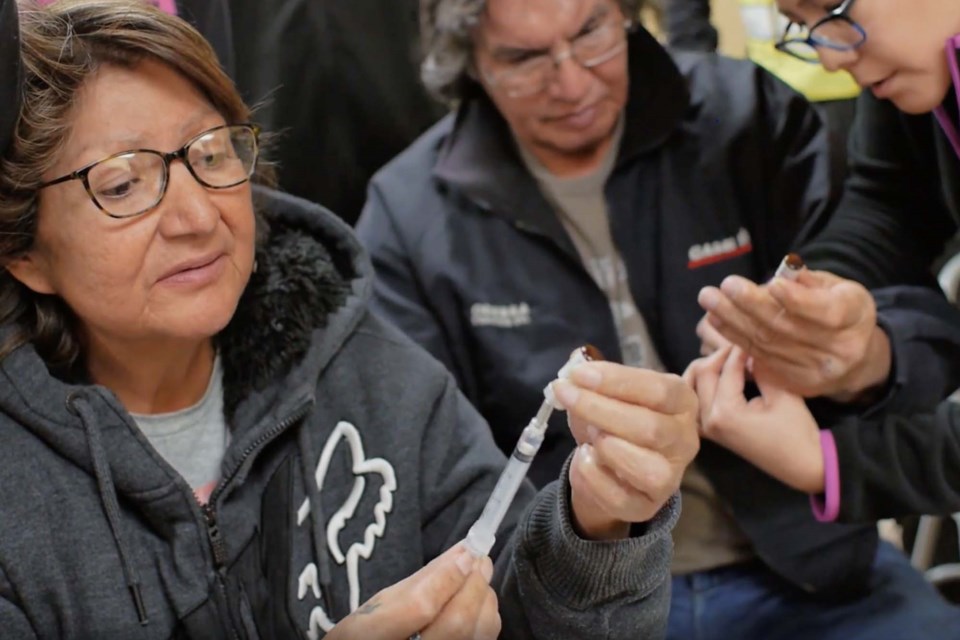REVIEW
Kímmapiiyipitssini: The Meaning of Empathy
Stars: 5.0
Directed by Elle-Máijá Tailfeathers
Rated: PG for coarse language, frank discussions of abuse, trauma, and substance use, depictions of substance use disorders and addictions, and for off-screen overdoses
Runtime: 125 minutes
Original version in English and Blackfoot with English subtitles
A Seen Through Woman production in conjunction with the National Film Board.
The film screens on Saturday and Sunday, Nov. 20 and 21 at the Metro Cinema, 8712 109 St. in Edmonton
Visit metrocinema.org/production/kimmapiiyipitssini-the-meaning-of-empathy to learn more.
Harm reduction is the humane response to the opioid crisis that has killed thousands of people across this country.
One filmmaker now presents her documentary that also acts as an effective advocacy tool to help communities deal with this massive problem. Kímmapiiyipitssini: The Meaning of Empathy focuses in on the Kainai Reserve in southern Alberta. Director Elle-Máijá Tailfeathers might require a trigger warning for off-screen depictions of overdosing, but that's the reality of the overdose epidemic brought on by fentanyl.
Despite the difficult subject matter, it's one of the most heartening views on a community's solidarity. There, the Blackfoot have a word that means "giving kindness to each other." Kímmapiiyipitssini also means compassion, a message that Tailfeathers hopes reaches a larger, more influential audience.
"We've had a number of small screenings for different organizations, non-profits, Alberta Health Services, and different educational institutions. It's been really great to be able to dialogue with people who work on the front lines, and people who can hopefully influence policy. We're building our impact campaign right now, which is essentially a way of making sure that this film reaches its intended audience and hopefully has a positive impact in terms of changing the way people think about addiction and how we respond to addiction," she offered.
She spent five years working on the project, including a year of research and development, where she listened and learned both from people who live with a substance-use disorder and from those who work on the front lines, including paramedics, nurses, and doctors.
Her objective, she explained, was not simply to show the heartbreaking damage that has been caused by the crisis. She wanted also to document people's lived experiences as an educational tool for her community and for others as well.
"I also intended it to be an educational resource for people who can shape policy: educators, people working on the front lines, and anybody that's willing to learn more about why our communities are so deeply impacted by this opioid crisis," she continued, adding there is a lot of incredible work being done that shouldn't be overshadowed by all of the sadness.
"So much of what I was seeing in the news media were stories of tragedy and trauma, sorrow, grief, but not a whole lot documenting all of the hard work that was happening within the community and all of the strength that exists within the community.
"It's meant to be educational. It's meant to be a tool for dialogue. But it's also just meant to be a portrait of the love and the strength that exists in my community because we're so rarely documented in that way. So often we're seeing through a lens of tragedy and trauma, and we don't get to see the other side, which is that strength and that love and the beauty of my community."
When she started this project five years ago, she knew very little about harm reduction, she admitted, just like so many people who aren't already directly impacted by it. Now, she sees the beauty of it and wants to share the message.
"It was an incredible learning journey just to be able to understand really what harm reduction is and what it looks like on the ground, and how it can work within Indigenous communities," she said.
"I think it's really important for people to get this full picture of how complicated this issue is, and how there isn't one single solution, but that my community is implementing a whole number of solutions for this continuum of care to think about filling those gaps in approaching addiction and meeting the needs of people where they're at."




